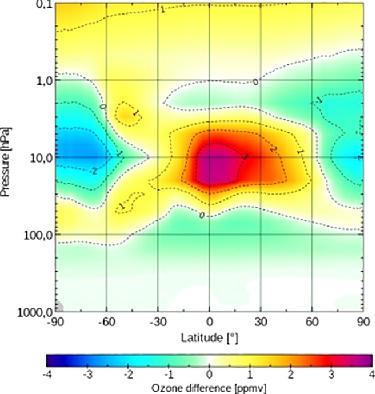当前位置:
X-MOL 学术
›
Q. J. R. Meteorol. Soc.
›
论文详情
Our official English website, www.x-mol.net, welcomes your feedback! (Note: you will need to create a separate account there.)
Use of variable ozone in a radiative transfer model for the global Météo‐France 4D‐Var system
Quarterly Journal of the Royal Meteorological Society ( IF 8.9 ) Pub Date : 2020-07-13 , DOI: 10.1002/qj.3869 O. Coopmann 1 , V. Guidard 1 , N. Fourrié 1 , B. Josse 1
Quarterly Journal of the Royal Meteorological Society ( IF 8.9 ) Pub Date : 2020-07-13 , DOI: 10.1002/qj.3869 O. Coopmann 1 , V. Guidard 1 , N. Fourrié 1 , B. Josse 1
Affiliation

|
Nowadays, the assimilation of satellite observations, particularly radiances from infrared sounders, into numerical weather prediction (NWP) models plays a dominant role in improving weather forecasts. One of the keys to make optimal use of radiances is to simulate them with a radiative transfer model (RTM). At Météo‐France, the RTTOV RTM is used for NWP models. Currently, simulations are carried out taking into account single chemical profiles. However, neglecting the spatial and temporal variability of these gases can affect the accuracy of the simulations and thus the quality of the subsequent analyses and forecasts. To reduce the impact of this assumption on weather forecasts, we use a variational bias correction but it would be more appropriate to correct the bias directly at the source. Ozone is one of the atmospheric constituents with significant impacts on spectral radiances measured by hyperspectral infrared sounders. Thus, the objective of this paper is to replace the use of a single ozone profile with a realistic and variable ozone field in RTTOV for the simulation of infrared observation. The results show that the use of a variable ozone allows us to further reduce biases in simulation of ozone‐sensitive channels but also of channels sensitive mainly to other parameters such as CO2 for example. This has positive effects on the analyses and improves the fit of the short‐range forecasts (or analyses) to other observations such as radiosondes, microwave radiances, GNSS‐RO bending angles, etc. All of these positive impacts allow us to significantly improve weather forecasts.
中文翻译:

在全球Météo-France4D-Var系统的辐射传输模型中使用可变臭氧
如今,将卫星观测(尤其是来自红外测深仪的辐射)同化为数值天气预报(NWP)模型在改善天气预报方面起着主导作用。最佳利用辐射的关键之一是使用辐射传递模型(RTM)对其进行仿真。在法国法兰西岛,RTTOV RTM用于NWP模型。当前,在考虑单一化学分布的情况下进行模拟。但是,忽略这些气体的时空变化会影响模拟的准确性,从而影响后续分析和预测的质量。为了减少该假设对天气预报的影响,我们使用了变化偏差校正,但更直接在源头校正偏差更合适。臭氧是对高光谱红外测深仪测得的光谱辐射有重大影响的大气成分之一。因此,本文的目的是在RTTOV中用真实且可变的臭氧场代替单一臭氧分布图,以模拟红外观测。结果表明,可变臭氧的使用使我们能够进一步减少模拟对臭氧敏感的通道,但对主要对其他参数(如CO)敏感的通道的偏差。以2为例。这对分析产生积极影响,并改善了短程预报(或分析)与其他观测值(如探空仪,微波辐射,GNSS-RO弯曲角度等)的拟合度。所有这些积极影响使我们能够显着改善天气预测。
更新日期:2020-07-13
中文翻译:

在全球Météo-France4D-Var系统的辐射传输模型中使用可变臭氧
如今,将卫星观测(尤其是来自红外测深仪的辐射)同化为数值天气预报(NWP)模型在改善天气预报方面起着主导作用。最佳利用辐射的关键之一是使用辐射传递模型(RTM)对其进行仿真。在法国法兰西岛,RTTOV RTM用于NWP模型。当前,在考虑单一化学分布的情况下进行模拟。但是,忽略这些气体的时空变化会影响模拟的准确性,从而影响后续分析和预测的质量。为了减少该假设对天气预报的影响,我们使用了变化偏差校正,但更直接在源头校正偏差更合适。臭氧是对高光谱红外测深仪测得的光谱辐射有重大影响的大气成分之一。因此,本文的目的是在RTTOV中用真实且可变的臭氧场代替单一臭氧分布图,以模拟红外观测。结果表明,可变臭氧的使用使我们能够进一步减少模拟对臭氧敏感的通道,但对主要对其他参数(如CO)敏感的通道的偏差。以2为例。这对分析产生积极影响,并改善了短程预报(或分析)与其他观测值(如探空仪,微波辐射,GNSS-RO弯曲角度等)的拟合度。所有这些积极影响使我们能够显着改善天气预测。



























 京公网安备 11010802027423号
京公网安备 11010802027423号